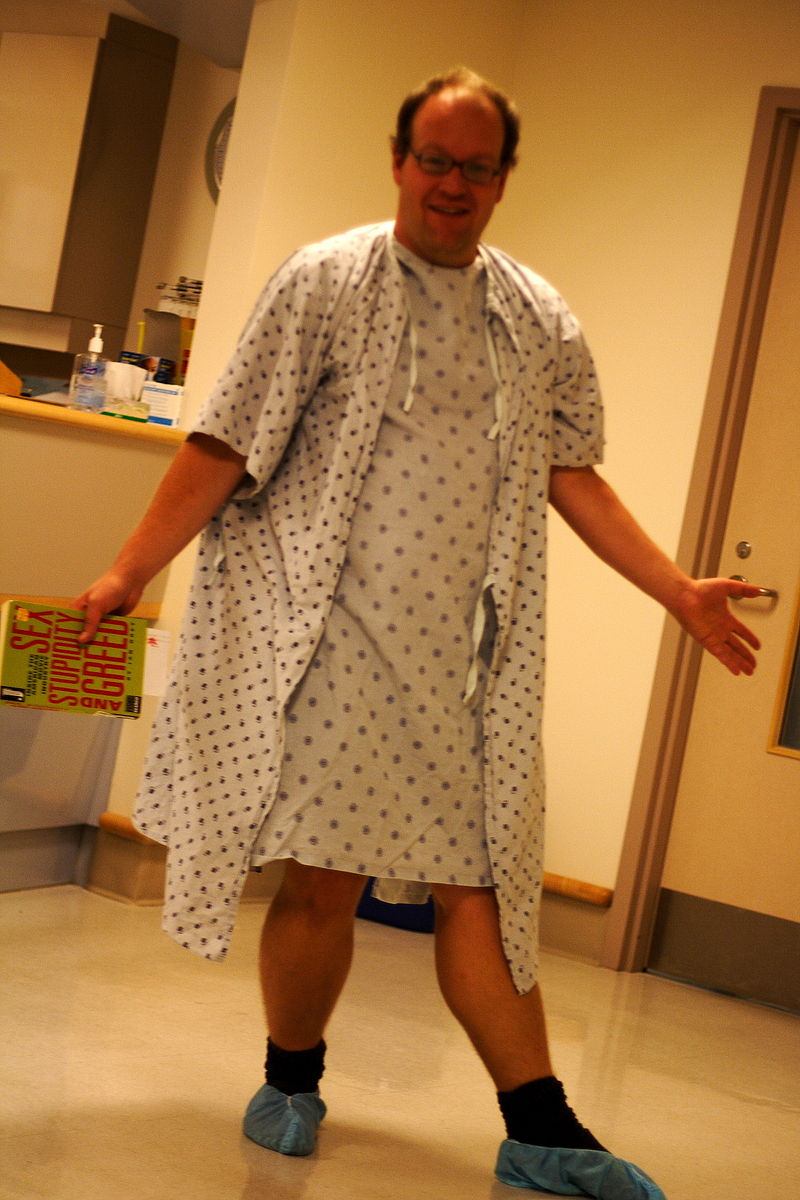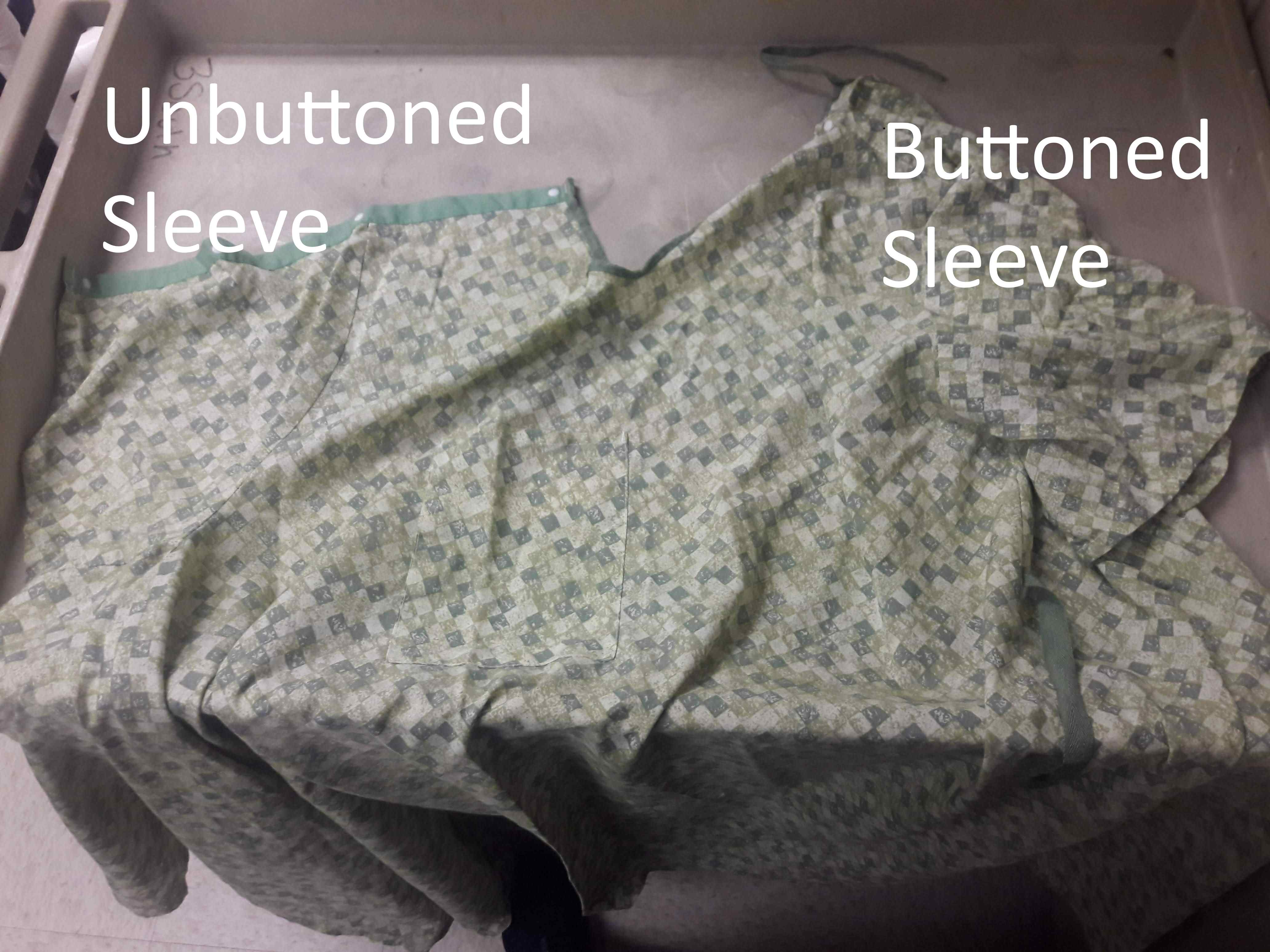How to Put On a Hospital Gown
Even after working with hospital gowns for years, I still get stumped trying to put one on a patient every now and then. They can be very tricky. Hopefully this page will help.
Different kinds Sleeves Tying it Finishing up
 2 hospital gowns front and back
2 hospital gowns front and backDifferent Kinds
Of course there are different sizes although at the hospital I work at, there are only two. It's better to have one too big rather than too small so when in doubt, use a larger one. Just make sure it's not dragging the ground or it will become a trip hazard and put the patient at a greater fall risk.
Some of them are designed like an isolation gown while others have buttons that connect the sleeves. Although they are the ones that are the most confusing to assemble, I personally like them more because they are easier to take off and maneuver around things like IVs.
Some of them also have a pocket in the front. This can be used to place a heart monitor in or even a jp drain. Just be careful and make sure the patient didn't leave anything in it before you throw it in the dirty linen bin.
 Hospital gown lying flat
Hospital gown lying flatPutting On the Sleeves
The easiest way to start putting a hospital gown on is to find the V-shape which goes at the front of the neck. There should be three or four buttons on either side for the sleeves.
If the patient doesn't have anything connected to a particular arm, or better still, both arms, I'll usually go ahead and button the sleeve together and slide their arm through normally.
However, if there is an IV or similar device in the patient's arm, put the highest end of the hospital gown over the shoulder and the lowest end underneath the patient's armpit. Then wrap the sleeve around the arm and shoulder until the buttons meet. Make sure the sleeve isn't twisted at all and then button it together.
Tying It Around
After the hospital gown is snug around the patient's shoulders, there should be two strings to tie it around the neck. One very useful trick I've learned is to tie it in front of the patient and then flip it around their head and down to their neck.
It definitely beats trying to tie it behind them especially if they can't lift their upper body very well. I've lost count of how many patients who told me how much easier that simple little trick makes it.
Most gowns can also be tied around the waist but if the patient is bedridden, it's probably safe to leave it untied. It gives them more room to breathe and there won't be a knot on their lower back.
Finishing Up
A lot of patients aren't too fond of wearing a hospital gown because they don't give much privacy. Make sure it is spread over them evenly covering as much of them as possible. I've known some to prefer to wear caregiver scrubs if the facility has extra although this isn't always an option.
You should also try to reduce the amount of wrinkles and make sure part of it isn't jumbled up underneath them. It only takes a few twists and turns for them to get all twisted under the patient.
From How to Put On a Hospital Gown to Home
Recent Articles
-
Common Truck Crash Injuries and Legal Remedies - Caregiverology
Jul 19, 25 10:49 AM
Known for its sun-drenched beaches, vibrant arts scene, and bustling maritime industry, Fort Lauderdale is a city that sees heavy traffic both on its roads and at its busy port. Unfortunately, with th… -
Why Expert Legal Help Matters After Serious Injury - Caregiverology
Jul 19, 25 10:35 AM
In Houston, over 67,600 car crashes occurred in 2023, resulting in 290 fatalities and 1,612 serious injuries. That’s roughly 185 accidents every day. -
How Life Care Planners Support Injury Recovery - Caregiverology
Jul 19, 25 10:18 AM
In Los Angeles, life care planners play a vital role in supporting injury recovery, especially for individuals facing catastrophic injuries such as traumatic brain injuries or spinal cord damage.





New! Comments
Have something to say about what you just read? Leave a comment in the box below.